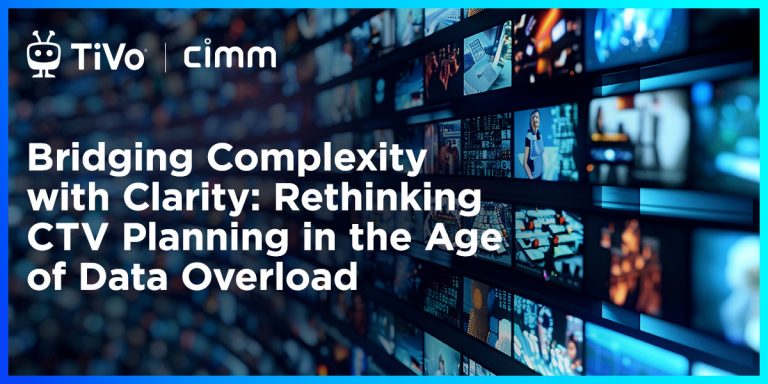By Fariba Zamaniyan, Global Vice President of Data Monetization, TiVo
I recently had the chance to speak at the CIMM East conference, where I joined a panel “Why Audience Insights are Crucial for Improved Planning When it Comes to CTV”. What started as a conversation about data and targeting quickly spiraled into something much bigger: a candid reckoning with the complexity — and opportunity — of modern media planning.
CTV, it turns out, is no longer the future. It’s the now. And with that immediacy comes pressure — to deliver results, justify spend, and, increasingly, to clean up the mess that the digital era has left in its wake.
From Experimentation to Expectation
There’s a quiet consensus forming in the industry: we’re past the trial phase. Advertisers are no longer satisfied with “directional” data or vague attribution models. They want proof. Precision. Outcomes. More importantly, the rigor and datasets we use on the backend of outcomes measurement should be same on the front-end when it comes to planning and audience development.
That was clear in every conversation I had at CIMM. We’ve entered a new chapter — one where CTV campaigns are expected to perform with the same rigour and measurability as their digital counterparts. The problem? Many of the inputs we’re working with still belong to the last era.
Data, once our saviour, has become both gift and curse. We have more of it than ever, yet questions persist about its quality, its representativeness, and the real-world insights it can deliver. Garbage in, garbage out — a reminder that scale means nothing if the underlying signals are weak and not reflective of truth.
The Identity
Identity, too, dominated the discourse. It’s meant to be the linchpin of modern targeting — the golden thread connecting viewers across platforms, devices, and formats. But at CIMM, what I heard repeatedly was just how fragmented and fragile that thread still is.
The industry’s obsession with identity is a kind of beautiful illusion: persistent ID solutions promise perfect reach and frequency, but most platforms still can’t speak to one another. Every “hop” in the data chain reduces accuracy. We’re stitching together ecosystems that weren’t built to be joined.
This isn’t just a tech issue — it’s strategic. If we can’t trust the inputs, how can we trust the outcomes?
At TiVo, we’re trying to cut through some of this noise by offering deterministic viewership data and comprehensive metadata with persistent program identification — but I’ll be the first to admit that the work is ongoing and we’re doing the “hop”. This is not a solved problem. Not yet.
The Resurrection of Context
Something else struck me at the event: content is making a comeback.
For years, digital-first media buying championed audience over everything. Who the person was mattered far more than what they were watching. But something’s shifting. Content is returning to the planning conversation, not as a side note, but as a driver of emotional engagement and brand safety.
As panelists shared examples from their own work, it became clear that brands — especially those targeting niche or multicultural audiences — are rediscovering the power of placing their message in the right content, not just any content.
This shift isn’t nostalgic. It’s strategic. And it drives outcomes. In a media landscape where attention is finite and algorithms are sometimes unreliable, relevance matters. Emotional tone matters. Safe, resonant environments matter.
And yet, much of the programmatic CTV infrastructure still isn’t designed for that kind of nuanced planning. We need better tools, better data consistency, and yes — better collaboration between publishers and platforms to make content adjacency more than a checkbox.
AI Is Fast. But It’s Not Wise.
Technology, of course, was the other elephant in the room. The rise of AI and automation is reshaping media planning at breakneck speed. Models can now process real-time feedback loops and adjust campaign strategies on the fly. Retail clients expect updates by the minute, not the week. But amid all this speed, one message resonated loudest with me: human interaction and relationships still matter.
AI can optimize. But it can’t empathize. It can crunch signals, but it can’t sense cultural nuance, emotional tone, or brand resonance. Especially when designing for diverse or underrepresented audiences, someone — a person — still needs to bring empathy and experience to the table.
That’s not a knock-on automation. It’s a plea for balance.
The Planning Reboot
Perhaps the biggest lesson I walked away with was this: we need to plan differently.
The old way — where you start with inventory and build outward — is broken. The new way? Start with the outcome. Define success. Build backwards. Use data to guide you, but only data you trust. Layer in context. Align with content. And above all, stay flexible.
At CIMM, everyone — from publishers to planners to platforms — is still finding their footing. But in that ambiguity lies opportunity.
So, Where Do We Go From Here?
We need fewer gimmicks and more structure. Less noise, more signal. We need to stop treating “data-driven” as synonymous with “good” and start interrogating what data we’re using — and why.
CTV can absolutely deliver on its promise. But it will take smarter planning, cleaner identity signals, stronger partnerships, and a deeper respect for the human side of media strategy.
Until then, I’ll take this with me from CIMM: clarity is possible — but only if we build it.
Watch the full event:


Comments are closed.